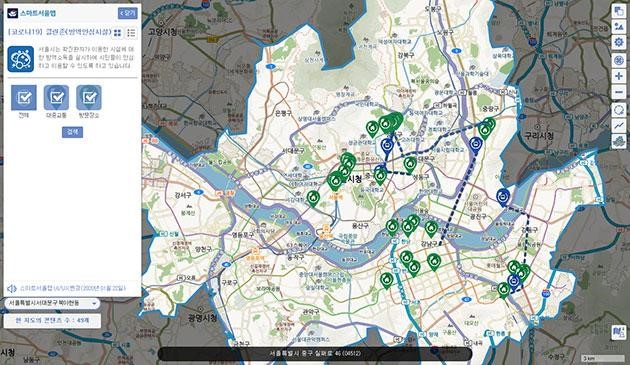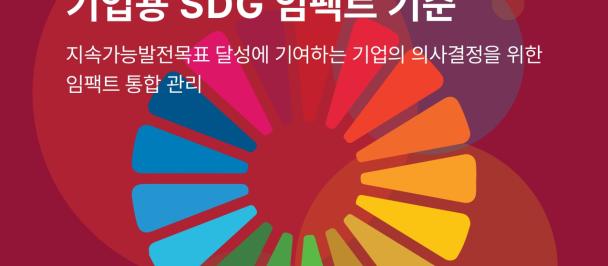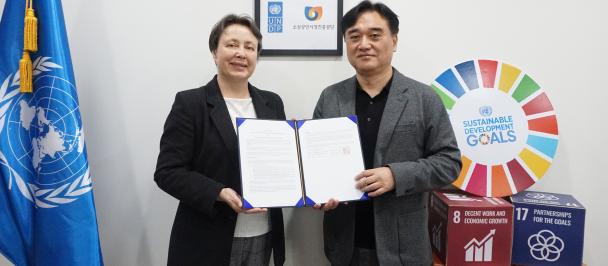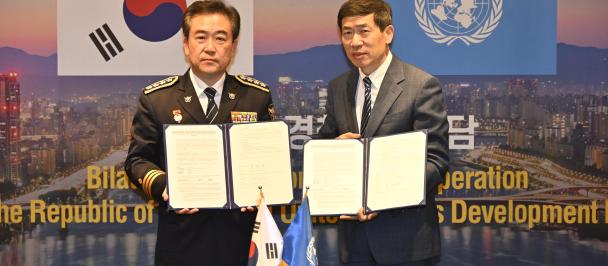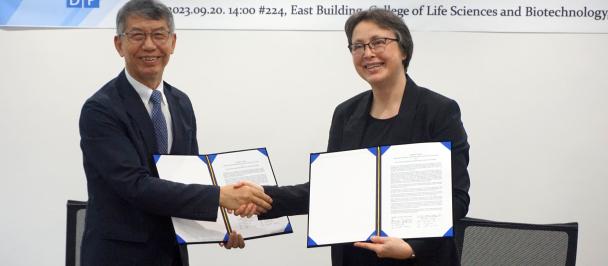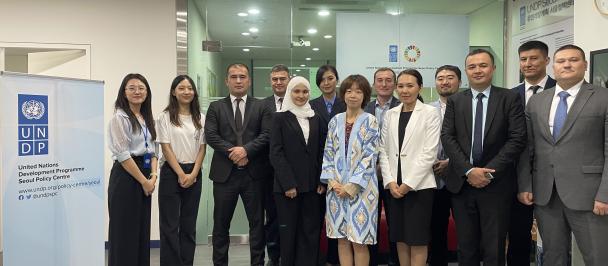Map of past itinerary of confirmed patients in Seoul. Green points show visited places and blue lines show travel routes by public transportation.
Public Disclosure of Information on COVID-19
ROK is known worldwide for its advanced ICT as well as for the transparency of public information. In dealing with the COVID-19 crisis, the Government has taken various measures of open data to disclose real-time information to alert citizens on the possible risks in view of the highly infectious nature of COVID-19. In addition to the daily briefings from the Korea Centers for Disease Control and Prevention (KCDC) through the traditional media, the area-specific information is disseminated by local government entities, through frequent phone-based emergency alert messages, websites, as well as mobile apps.
CBS-based emergency alerts
With the use of mobile technology, Korean citizens are getting the latest COVID-19 outbreak updates from both central and local government authorities, specific to their location.
Municipal governments in ROK provide real-time information on confirmed cases in respective cities and travel routes of confirmed patients through mobile phone-based “Emergency Alerts” using a Cell Broadcasting Service (CBS) available to all mobile stations within a defined geographic area regardless of subscription.
CBS utilizes a cell phone’s paging channel to send out customized emergency alerts according to users’ location. The Ministry of the Interior and Safety (MOIS) in collaboration with the Korea Meteorological Administration (KMA), related government agencies and local governments, mobile carrier companies (SKT, KT, LGU+) and cell phone manufacturing companies run an emergency alert system to effectively respond to natural and man-made disasters.
These alert messages disclose detailed information on the itineraries of each confirmed patient (i.e. where, and when they visited the location, after developing the symptoms), as well as status updates on disinfection and the epidemiological survey of the most recently confirmed cases. Messages also ask and urge citizens who may have visited a newly discovered infection point to immediately get tested at nearby testing facilities.
Emergency alert message example:
|
[Alert from Yeonsu District Office] Update: One confirmed COVID-19 case reported in Ongnyeon 2-dong (town). Past itineraries of the confirmed patient to be publicized on the website and social media of Yeonsu District Office after disinfection and epidemiological investigation. |
CBS which is administered by MOIS is delegated to 17 municipal governments in ROK to ensure a prompt response in a crisis, and targeted approaches and field-based solutions.
Open database website by Seoul Metropolitan Government
Seoul Metropolitan Government (SMG) is well known for its public information disclosure policy. The website quickly developed by SMG allows citizens to access the latest list of confirmed patients’ information, including date of infection confirmation, location of residence along with information on their itinerary (or “infection points”)—i.e. where and when they visited after developing symptoms. They only disclose the exact hour of their visits without containing detailed information on the name of restaurants and shops in order to minimize privacy risk.
As clusters of infected cases emerged from church, club, rally, workplace, and other gatherings, SMG disclosed number of confirmed patients by different infection routes.
<Confirmed patients by infection route and cluster>
|
Infection Route |
Number |
Infection Route |
Number |
|
Contact with incoming foreign travelers |
382 |
Yoido Full Gospel Church |
21 |
|
Full Gospel Gangbuk Church |
15 |
FA Physical Education College Prep Academy |
28 |
|
Seongbuk Sarang Church |
533 |
Itaewon Club |
139 |
|
Independence Day rally |
43 |
Guro Call Centre |
98 |
|
Theater company ‘San’ |
24 |
Contact with patients from other cities / province |
116 |
|
Unidentified infection route |
483 |
Other |
992 |
<Itinerary disclosure of a confirmed patient>
|
District |
Place Type |
Name of Place/Business (Address) |
Visit Date |
Disinfection Status |
Remarks |
|
Hwigyeong 2-dong |
Funeral Parlor |
Non-disclosure (Contact tracing completed) |
19/08/2020 (Wed.) 04:30AM~05:00AM |
Disinfection completed by the concerned business |
Facial Mask used, Transportation means: taxi |
|
Cheongnyangni-dong |
Hospital |
Non-disclosure (Contact tracing completed) |
21/08/2020 (Fri.) 10:10AM~10:43AM |
Disinfection completed |
Facial Mask used, Transportation means: bicycle |
|
Cheongnyangni-dong |
Pharmacy |
Non-disclosure (Contact tracing completed) |
21/08/2020 (Fri.) 10:46AM (credit card transaction timestamp) |
Disinfection Completed |
Facial Mask used, Transportation means: bicycle |
|
Yongsin-dong |
Medical Institute |
Dongdaemun-gu Screening Clinic (Cheonho-daero 145) |
23/08/2020 (Sun.) 11:00AM |
Disinfection completed by the concerned business |
Facial Mask used, Transportation means: private car |
|
Cheongyangni-dong |
Grocery shop |
Non-disclosure (Contact tracing completed) |
23/08/2020 (Sun.) 11:30AM (credit card transaction timestamp) |
Disinfection completed |
Facial Mask used, Transportation means: private car |
|
Cheongyangni-dong |
Restaurant |
Non-disclosure (Contact tracing completed) |
23/08/2020 (Sun.) 17:49PM (credit card transaction timestamp) |
Disinfection completed |
Facial Mask used, Transportation means: private car |
|
Public transportation |
Taxi |
19/08/2020 (Wed.) 04:00-04:20AM (Home – Funeral Parlor) |
Disinfection completed by the concerned business |
Facial Mask used, Transportation means: private car |
|
|
Other district |
Disclosed by respective district |
19/08/2020 (Wed.) 05:30-10:00 |
Funeral car |
Such information is intended to enable residents to take precautionary measures and to monitor and report on their conditions if they develop symptoms after having visited the “infection points” at the same hours as the patients. The information is updated several times a day. SMG also has made a mobile application that provides the same information for convenience.
In order to mitigate the side effects on businesses (due to people avoiding the places even after disinfection) and privacy infringement, KCDC has also developed and distributed ‘Information Disclosure Guidelines’. The guidelines stipulate the scope and timeline of disclosure, disclosure period, etc. For example, any information revealing the identity of confirmed patients -i.e. their sex, age, nationality/ethnicity, residence area, or affiliated company- must not be publicized; if all those who physically contacted with confirmed patients are traced, the government must not disclose the name of places that confirmed patients had visited.

 Locations
Locations